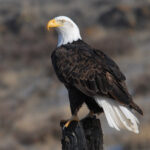Yes, bald eagles do eat roadkill. This behavior is particularly common in the winter months when dead animals are frozen and aren’t likely to be covered with maggots, making them a more appealing food source for the eagles.
The Scavenging Behavior of Bald Eagles
Bald eagles are opportunistic feeders and will take advantage of any food source that is available to them. Scavenging on roadkill is a normal part of their feeding strategy, as it allows them to conserve energy and obtain a reliable source of food.
Factors that Influence Bald Eagles’ Scavenging Behavior
- Availability of Roadkill: Bald eagles are more likely to scavenge on roadkill during the winter months when other food sources may be scarce or frozen.
- Condition of the Roadkill: Bald eagles prefer roadkill that is fresh and not covered in maggots, as this can make the meat less appealing and potentially harmful to the birds.
- Presence of Competitors: Bald eagles may be more inclined to scavenge on roadkill if there is less competition from other predators or scavengers in the area.
Risks Associated with Bald Eagles Eating Roadkill
While scavenging on roadkill is a normal behavior for bald eagles, it can also pose risks to their health. One of the primary concerns is the potential for lead poisoning.
Lead Poisoning
Bald eagles can ingest lead from legally shot deer that have been field dressed by hunters. This lead can accumulate in the eagles’ bodies, leading to lead poisoning and causing the birds to exhibit unusual behavior, such as getting hit by cars.
Other Risks
In addition to lead poisoning, bald eagles that feed on roadkill may also be at risk of contracting diseases or parasites from the dead animals. Furthermore, the act of scavenging on the side of the road can put the eagles in danger of being struck by passing vehicles.
Bald Eagles’ Adaptations for Scavenging
 Image source: Bald Eagle (Haliaeetus leucocephalus) in Kachemak Bay, Alaska
Image source: Bald Eagle (Haliaeetus leucocephalus) in Kachemak Bay, Alaska
Bald eagles have several physical adaptations that make them well-suited for scavenging on roadkill and other food sources.
Powerful Beak and Talons
Bald eagles have a strong, hooked beak and sharp talons that allow them to tear through the tough skin and flesh of dead animals. This enables them to efficiently consume their prey, even if it is partially decomposed.
Keen Eyesight
Bald eagles have excellent eyesight, which helps them spot potential food sources from a distance. This is particularly useful when searching for roadkill, as the eagles can scan the roadsides for any signs of dead animals.
Efficient Digestion
Bald eagles have a highly efficient digestive system that allows them to extract nutrients from a wide range of food sources, including carrion. This adaptability helps them thrive in environments where food may be scarce or unpredictable.
Conclusion
In conclusion, bald eagles do eat roadkill, and this behavior is a normal part of their feeding strategy. While scavenging can pose some risks to the eagles’ health, it is an important way for them to conserve energy and obtain a reliable source of food, particularly during the winter months. By understanding the factors that influence bald eagles’ scavenging behavior and the adaptations that make them well-suited for this activity, we can better appreciate the resilience and adaptability of these magnificent birds of prey.




